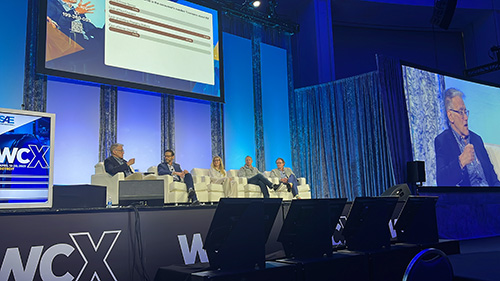Is Net Zero By 2050 possible? WCX Panelists Talk Energy Infrastructure and EVs at WCX
Posted: April 19, 2023
The transportation industry is one of the largest contributors to carbon pollution, accounting for 27 percent of the greenhouse gas emissions in the U.S., according to the EPA.
As part of the push to net zero by 2050, the mobility industry is looking to do its part by embracing clean energy, but a move toward electric vehicles has raised questions about the feasibility of a wide scale adoption based around charging infrastructure concerns.

During SAE International’s 2023 WCX, panelists Mark Bole, General Motors, Alex Ehrett, ABB E-mobility, Trent Warnke, Rivian Automotive LLC, and Justin Wilson, ChargePoint, moderated by SAE International’s Frank Menchaca, President of Sustainable Mobility Solutions, got together to talk infrastructure and answer burning questions on the minds of consumers and industry experts.
The panelists discussed the importance of an inclusive workforce with appropriate training to maintain charging systems as one of the key components in making a large-scale shift to electric vehicles possible. Part of that can come from starting education early and making sure options are widely available and known.
“It’s really getting to the students at a younger age so that way when they’re ready to enter the workforce, we’re eager to hire them,” Ehrett said. “So, we need to set up that safe pipeline specific to charging and electric vehicles.”
Getting interest in this work, and beyond that, encouraging adoption of electric vehicles, can be dependent on public perception, making it critical to help the broader consumer audience to understand the charging infrastructure.
Criticisms around current offerings include a perception of charging failure, or a national electric grid incapable of supporting widespread adoption of EVs. To combat this, the panelists highlighted a few things critical to success.
“We need to make products that work, and we have to prove ourselves,” Bole said. “It’s about getting out and executing in the marketplace, making it simple for consumers.”
Also important to note is that charging infrastructure is dependent on continuous improvement and upkeep, and not based around, as Ehrett described, a “set it and forget it” mentality.
To be a part of that continuous evolution, manufacturers, utilities and legislators alike need to understand the needs of the market, and that understanding is already in motion.
“It’s great to see companies who are out there doing pilot programs, but we need to get beyond pilot programs very quickly,” Warnke said. “The technology already exists. We can do it today. So it’s not the technology that’s holding us back, it’s a lot of the rules, regulations and legislative action around this space. There’s a lot of players we need to bring together. So to answer the question of what the grid needs, it needs us to work together.”
And as for concerns that we don’t have enough energy to charge the targeted electric vehicle adoption number by 2035—the panelists don’t see that as a problem.
“Utilities across the country are great at doing this work,” Wilson said. “I trust they will meet the needs of transportation electrification.”
